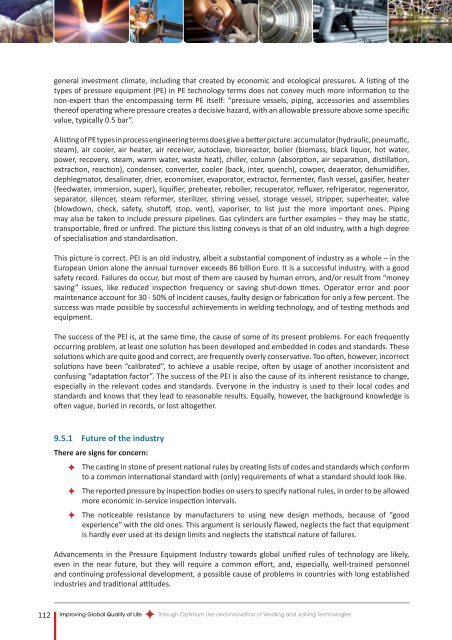Improving Global Quality of Life
Improving Global Quality of Life
Improving Global Quality of Life
You also want an ePaper? Increase the reach of your titles
YUMPU automatically turns print PDFs into web optimized ePapers that Google loves.
general investment climate, including that created by economic and ecological pressures. A listing <strong>of</strong> the<br />
types <strong>of</strong> pressure equipment (PE) in PE technology terms does not convey much more information to the<br />
non-expert than the encompassing term PE itself: “pressure vessels, piping, accessories and assemblies<br />
there<strong>of</strong> operating where pressure creates a decisive hazard, with an allowable pressure above some specific<br />
value, typically 0.5 bar”.<br />
A listing <strong>of</strong> PE types in process engineering terms does give a better picture: accumulator (hydraulic, pneumatic,<br />
steam), air cooler, air heater, air receiver, autoclave, bioreactor, boiler (biomass, black liquor, hot water,<br />
power, recovery, steam, warm water, waste heat), chiller, column (absorption, air separation, distillation,<br />
extraction, reaction), condenser, converter, cooler (back, inter, quench), cowper, deaerator, dehumidifier,<br />
dephlegmator, desalinater, drier, economiser, evaporator, extractor, fermenter, flash vessel, gasifier, heater<br />
(feedwater, immersion, super), liquifier, preheater, reboiler, recuperator, refluxer, refrigerator, regenerator,<br />
separator, silencer, steam reformer, sterilizer, stirring vessel, storage vessel, stripper, superheater, valve<br />
(blowdown, check, safety, shut<strong>of</strong>f, stop, vent), vaporiser, to list just the more important ones. Piping<br />
may also be taken to include pressure pipelines. Gas cylinders are further examples – they may be static,<br />
transportable, fired or unfired. The picture this listing conveys is that <strong>of</strong> an old industry, with a high degree<br />
<strong>of</strong> specialisation and standardisation.<br />
This picture is correct. PEI is an old industry, albeit a substantial component <strong>of</strong> industry as a whole – in the<br />
European Union alone the annual turnover exceeds 86 billion Euro. It is a successful industry, with a good<br />
safety record. Failures do occur, but most <strong>of</strong> them are caused by human errors, and/or result from “money<br />
saving” issues, like reduced inspection frequency or saving shut-down times. Operator error and poor<br />
maintenance account for 30 - 50% <strong>of</strong> incident causes, faulty design or fabrication for only a few percent. The<br />
success was made possible by successful achievements in welding technology, and <strong>of</strong> testing methods and<br />
equipment.<br />
The success <strong>of</strong> the PEI is, at the same time, the cause <strong>of</strong> some <strong>of</strong> its present problems. For each frequently<br />
occurring problem, at least one solution has been developed and embedded in codes and standards. These<br />
solutions which are quite good and correct, are frequently overly conservative. Too <strong>of</strong>ten, however, incorrect<br />
solutions have been “calibrated”, to achieve a usable recipe, <strong>of</strong>ten by usage <strong>of</strong> another inconsistent and<br />
confusing “adaptation factor”. The success <strong>of</strong> the PEI is also the cause <strong>of</strong> its inherent resistance to change,<br />
especially in the relevant codes and standards. Everyone in the industry is used to their local codes and<br />
standards and knows that they lead to reasonable results. Equally, however, the background knowledge is<br />
<strong>of</strong>ten vague, buried in records, or lost altogether.<br />
9.5.1 Future <strong>of</strong> the industry<br />
There are signs for concern:<br />
The casting in stone <strong>of</strong> present national rules by creating lists <strong>of</strong> codes and standards which conform<br />
to a common international standard with (only) requirements <strong>of</strong> what a standard should look like.<br />
The reported pressure by inspection bodies on users to specify national rules, in order to be allowed<br />
more economic in-service inspection intervals.<br />
The noticeable resistance by manufacturers to using new design methods, because <strong>of</strong> “good<br />
experience” with the old ones. This argument is seriously flawed, neglects the fact that equipment<br />
is hardly ever used at its design limits and neglects the statistical nature <strong>of</strong> failures.<br />
Advancements in the Pressure Equipment Industry towards global unified rules <strong>of</strong> technology are likely,<br />
even in the near future, but they will require a common effort, and, especially, well-trained personnel<br />
and continuing pr<strong>of</strong>essional development, a possible cause <strong>of</strong> problems in countries with long established<br />
industries and traditional attitudes.<br />
112 <strong>Improving</strong> <strong>Global</strong> <strong>Quality</strong> <strong>of</strong> <strong>Life</strong> Through Optimum Use and Innovation <strong>of</strong> Welding and Joining Technologies
















